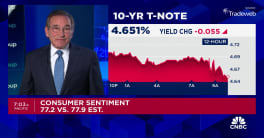Despite poor data and talk of more regulation, markets are on the gain 90 minutes into Thursday’s session.
The S&P 500 opened high on Thursday, dipped into negative shortly before 10 am, but has since retraced the losses to be up 0.64% to 889.57. The Dow traced a similar course and is up 0.41% to 8319.22; and the Nasdaq has managed to stay positive all morning, currently up 1.07% to 1681.17.
The indexes have managed to eke out gains even as Treasuries trade higher, oil futures head south, and pre-session data points were weak.
Initial Jobless Claims showed 637,000 Americans filed for unemployment benefits in the week ending May 9, much higher than the consensus forecast of 610k or the prior week’s 605k reading. Continuing Claims ― the total number of people receiving jobless benefits ― soared far beyond its highest level ever at 6.560 million for the week ending May 2.
Also released at 8:30, the Producer Price Index increased 0.3% in April, against expectations for a 0.1% gain and following a 1.2% decline in March. The core index ― which excludes volatile food and energy components ― advanced by 0.1% in the month, in line with forecasts and following a flat reading in March.
Annually, producer prices have fallen 3.7% since this time last year; core prices have increased 3.4%.
Aside from data, media reports on Thursday pointed to mixed news for the housing market.
On the positive side, the Financial Times reported that a surge in refinancing is “creating a boom in the home lending business, prompting banks to hire thousands of new employees and put them to work on extra shifts to process mountains of paperwork.”
However, the New York Times reported that government plans to help millions of troubled homeowners avoid foreclosure is hitting some hurdles. Only 55,000 homeowners have been extended loan modification offers so far, while foreclosure filings reached 342,000 last month alone.
The NYT article implies the program may be doomed until the economy picks up: “The longer it takes to set the program in motion . . . the fewer people will qualify for modifications. The expected rise in unemployment in coming months may keep a growing number of homeowners out of the program.”
According to Moody’s, about 15.4 million borrowers, or 20% of single-family homeowners, are nearing default.







